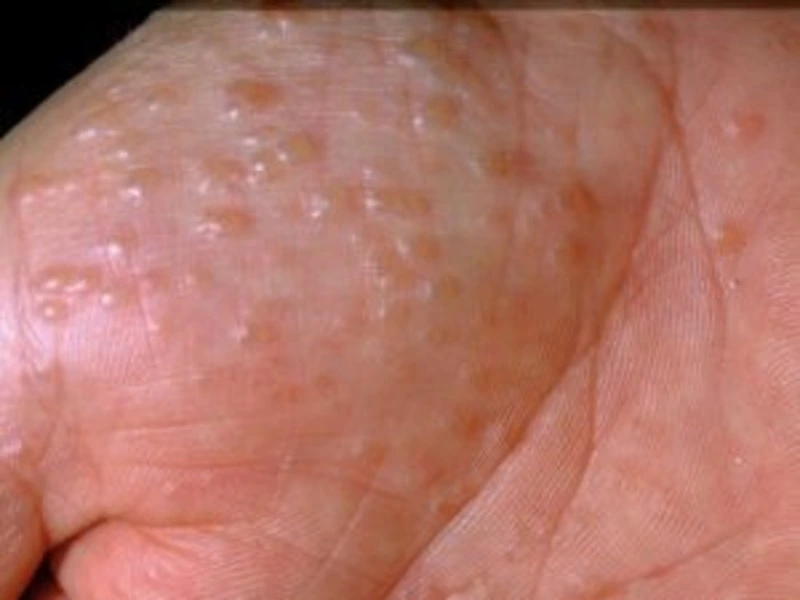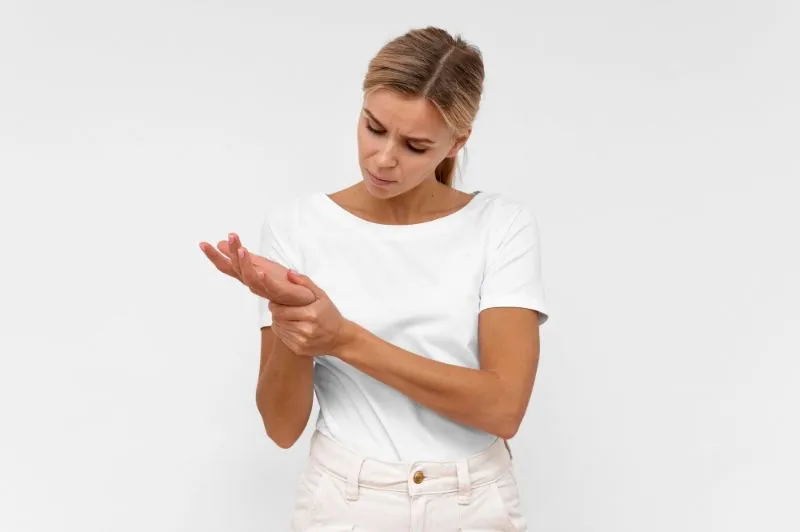Dyshidrosis is a common skin condition that affects individuals worldwide. It is characterized by small, itchy blisters that primarily appear on the hands and feet. This comprehensive blog post will provide a detailed overview of dyshidrosis, including its causes, symptoms, and prevalence. Additionally, we will explore various management strategies, lifestyle tips, natural remedies, coping techniques, and preventive measures to help you navigate this condition and live a fulfilling life.
Overview of Dyshidrosis
Dyshidrosis, or dyshidrotic eczema, is a common type of vesicular hand dermatitis that primarily affects the sides of the fingers and toes, as well as the palms of the hands and soles of the feet. It is characterized by recurrent episodes of small blisters, often grouped together, resembling clusters or "tapioca pudding." These blisters are filled with fluid, and individuals may experience intense itching and discomfort.
Prevalence of Dyshidrosis
The prevalence of dyshidrosis can vary significantly. It is estimated to affect 5-20% of individuals with hand eczema. This condition is more frequently observed in warmer climates and during the spring and summer months, known as seasonal or summer pompholyx. The male-to-female ratio for dyshidrotic eczema varies and has been reported as 1:1 or 1:2. It can affect individuals ranging from 4 to 76 years of age, with the highest incidence observed in patients aged 20-40 years.
Causes and Risk Factors of Dyshidrosis
The exact cause of dyshidrosis is not fully understood, but research suggests that it is a multifactorial condition influenced by various factors. Allergies play a role, as individuals with a history of allergic conditions or sensitivities are more prone to developing dyshidrosis. Contact with irritants, such as certain metals, detergents, or solvents, can trigger or exacerbate the condition. Genetics also plays a role, as dyshidrosis tends to run in families. People with a family history of eczema or atopic dermatitis are more likely to develop dyshidrosis. Sweating can contribute to dyshidrosis, particularly in warm weather or during physical activities. Excessive sweating or prolonged exposure to moisture can disrupt the skin's natural balance and increase the risk of blister formation. Additionally, stress and emotional factors have been associated with dyshidrosis, as stress can trigger or worsen flare-ups, possibly due to the release of stress hormones that affect the immune system and skin barrier function.
Symptoms of Dyshidrosis
The symptoms of dyshidrosis include the formation of small blisters filled with fluid, intense itching, and redness in the affected areas. These blisters can be very small, typically measuring 1-2 mm, and may be grouped together, resembling clusters or "tapioca pudding.” Blisters can be painful and may cause discomfort during everyday activities, such as gripping objects or walking. The severity and frequency of flare-ups can vary from person to person, with some experiencing occasional mild episodes while others have more persistent and severe symptoms.
By understanding the causes, symptoms, and prevalence of dyshidrosis, individuals can seek appropriate treatment and develop effective management strategies to minimize its impact on their daily lives.

Diagnosis of Dyshidrosis: Understanding the Process and Seeking Medical Evaluation
If you suspect that you have dyshidrosis, it is important to seek a proper diagnosis from a healthcare professional. A dermatologist or allergist can evaluate your symptoms, medical history and perform necessary tests to confirm the presence of dyshidrosis and rule out other conditions. Here's an overview of the diagnosis process for dyshidrosis:
Medical History: Your healthcare provider will begin by asking about your symptoms and medical history. Be prepared to provide information about when the symptoms started, their duration, potential triggers or factors that worsen them, and any family history of skin conditions and allergies.
Physical Examination: A visual examination of the affected areas will be conducted. Your healthcare provider will examine the characteristic blisters, redness, and other skin changes associated with dyshidrosis. They may also examine other areas of your skin to assess for any additional signs of eczema or related conditions.
Patch Testing: In some cases, patch testing may be recommended to identify any specific allergens or irritants that may be triggering your dyshidrosis. Patch testing involves applying small amounts of various substances to patches that are placed on your skin for a specified period. This helps determine if you have any allergic reactions to specific substances.
Differential Diagnosis: Your healthcare provider may consider other conditions that can present with similar symptoms, such as allergic contact dermatitis, fungal infections, or psoriasis. They will assess these possibilities and rule out other conditions to arrive at an accurate diagnosis.
Once a diagnosis of dyshidrosis is confirmed, your healthcare provider will discuss appropriate treatment options and provide recommendations for managing your condition. They may also offer guidance on lifestyle modifications, preventive measures, and strategies to minimize flare-ups.
It is important to remember that self-diagnosis may not always be accurate, and seeking professional evaluation is essential for an accurate diagnosis and appropriate treatment. If you are experiencing symptoms suggestive of dyshidrosis, it is advisable to consult a healthcare professional who can provide the necessary expertise and guidance.
Common Treatments for Dyshidrosis: Exploring Effective Options
Various treatment options are available to manage dyshidrosis and alleviate its symptoms. The choice of treatment depends on the severity of the condition and individual preferences. It is recommended to consult a healthcare professional to determine the most suitable treatment plan for your specific situation. Common treatment approaches include:
Topical Steroids: Topical corticosteroids are commonly prescribed to reduce inflammation and itching. They come in various strengths, and your healthcare provider will determine the most appropriate one for you based on the severity of your symptoms and the affected areas.
Topical Calcineurin Inhibitors: In cases where topical steroids may not be suitable or effective, topical calcineurin inhibitors, such as tacrolimus or pimecrolimus, may be prescribed. These non-steroidal medications help to suppress the immune response and reduce inflammation. They are often reserved for sensitive areas or when topical steroids have not provided satisfactory results.
Moisturizers and Emollients: Regularly applying moisturizers and emollients can help hydrate the skin and restore its natural barrier function. Look for products specifically designed for sensitive or eczema-prone skin, and apply them liberally after bathing or whenever your skin feels dry.
Phototherapy: In some cases, phototherapy or light therapy may be recommended. This involves exposure to controlled amounts of ultraviolet (UV) light to reduce inflammation and suppress the immune response in the affected areas.
Other Therapies: In severe or refractory cases, systemic medications, such as oral corticosteroids or immunosuppressants, may be prescribed. However, these options come with potential side effects and should be carefully monitored by a healthcare professional.
Dyshidrosis Self-Care Natural Remedies: Seeking Relief for Dyshidrosis Symptoms
While there is limited scientific evidence supporting the effectiveness of natural remedies for dyshidrosis, some individuals find them helpful in managing symptoms. It's important to note that natural remedies should be used with caution and under the guidance of a healthcare professional. Here are a few dyshidrosis self-care natural remedies that some people have found beneficial:
Aloe Vera: Aloe vera gel, known for its soothing properties, can provide temporary relief from itching and inflammation. Apply a thin layer of pure aloe vera gel to the affected areas.
Oatmeal: Taking oatmeal baths or using oatmeal-based products can help soothe irritated skin and reduce itching. Finely ground colloidal oatmeal can be added to lukewarm bathwater or used as a compress.
Tea Tree Oil: Tea tree oil has antimicrobial and anti-inflammatory properties that may help alleviate symptoms. Dilute tea tree oil with a carrier oil, such as coconut or jojoba oil, and apply it sparingly to the affected areas.
Cold Compresses: Applying cold compresses or ice packs to the blisters can provide temporary relief from itching and help reduce inflammation. Wrap the ice pack in a thin cloth to protect the skin.
Skincare Routine: Establish a gentle skincare routine that includes mild cleansers, lukewarm water, and fragrance-free moisturizers. Avoid harsh soaps and excessive scrubbing, as these can irritate the skin.
Trigger Avoidance: Identify and minimize exposure to triggers, such as allergens, irritants, and excessive sweating. Use protective measures like gloves, avoid wearing tight-fitting shoes or socks for long periods, and opt for breathable materials.
Stress Management: Stress can trigger or worsen dyshidrosis flare-ups. Incorporate stress management techniques into your daily routine, such as meditation, deep breathing exercises, yoga, or engaging in hobbies that help you relax.
Overall Skin Health: Take care of your skin's overall health by maintaining a balanced diet, staying hydrated, and avoiding excessive exposure to harsh environmental conditions, like extreme temperatures or dry air. Ensure you get adequate sleep to support your body's natural healing processes.
However, it's important to consult with a healthcare professional before trying any dyshidrosis self-care natural remedies to ensure they are suitable for your specific condition.
When to Seek Medical Help: Recognizing Warning Signs and Complications
While many cases of dyshidrosis can be managed with self-care and lifestyle adjustments, it's important to recognize when medical assistance is necessary. Seek professional evaluation and treatment if you experience:
Severe or Persistent Symptoms: If your symptoms are severe, persistent, or worsening despite self-care efforts, it's crucial to consult a healthcare professional for further evaluation and appropriate treatment.
Infection: If you notice signs of infection, such as increased redness, swelling, warmth, pain, or discharge from the blisters, seek immediate medical attention. Infections require prompt treatment to prevent complications.
Impaired Daily Functioning: If dyshidrosis significantly affects your daily activities, work performance, or emotional well-being, consult a healthcare professional who can help you develop an individualized management plan.
By being aware of these warning signs and complications, you can make informed decisions about seeking medical help and ensuring the best possible care for your condition.
Conclusion
In conclusion, managing dyshidrosis can be complex, requiring a comprehensive approach that combines medical interventions, lifestyle adjustments, and emotional support. At Cura4U, we understand the challenges posed by dyshidrosis and are committed to providing accessible healthcare services to support your journey towards healthier skin. Our team of healthcare professionals offers telemedicine consultations and a range of primary healthcare services, allowing you to receive expert guidance and personalized treatment plans from the comfort of your home. Whether you need assistance with dyshidrosis or other common conditions, we are here to help. Take the first step towards managing your health by booking an appointment with our experienced professionals at Cura4U today.
Our clinical experts continually monitor the health and medical content posted on CURA4U, and we update our blogs and articles when new information becomes available. Last reviewed by Dr. Saad Zia on July 3rd, 2023.
References
Dyshidrotic Eczema (Pompholyx): Practice Essentials, Background, Etiology (medscape.com)- https://emedicine.medscape.com/article/1122527-overview
Dyshidrotic eczema: symptoms, causes, and treatment (nationaleczema.org)- https://nationaleczema.org/eczema/types-of-eczema/dyshidrotic-eczema/
Eczema types: Dyshidrotic eczema signs and symptoms (aad.org)- https://www.aad.org/public/diseases/eczema/types/dyshidrotic-eczema/symptoms
Dyshidrosis - Symptoms and causes - Mayo Clinic- https://www.mayoclinic.org/diseases-conditions/dyshidrosis/symptoms-causes/syc-20352342#:~:text=Dyshidrosis%20is%20a%20skin%20condition,weeks%20and%20often%20come%20back.
Dyshidrotic Eczema: A Common Cause of Palmar Dermatitis - PMC (nih.gov)- https://www.ncbi.nlm.nih.gov/pmc/articles/PMC7647841/
Dyshidrosis: Epidemiology, Clinical Characteristics, and Therapy | DERM (liebertpub.com)- https://www.liebertpub.com/doi/abs/10.2310/6620.2006.05021
Europe PMC- https://europepmc.org/article/med/11767355











